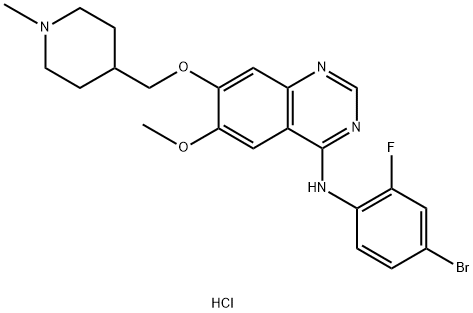vandetanib is an anti-cancer drug that is used for the treatment of certain tumours of thethyroid gland. it acts as a kinase inhibitor of a number of cell receptors, mainly the vascular endothelial growth factor receptor (vegfr), the epidermal growth factor receptor (egfr), and the ret-tyrosine kinase.
vandetanib also inhibits vegfr3 and egfr with ic50 of 110 nm and 500 nm, respectively. vandetanib is not sensitive to pdgfrβ, flt1, tie-2 and fgfr1 with ic50 of 1.1-3.6 μm, while almost has no activity against mek, cdk2, c-kit, erbb2, fak, pdk1, akt and igf-1r with ic50 above 10 μm. vandetanib inhibits vegf-, egf- and bfgf-stimulated huvec proliferation with ic50 of 60 nm, 170 nm and 800 nm, with no effect on basal endothelial cell growth. vandetanib inhibits tumor cell growth with ic50 of 2.7 μm (a549) to 13.5 μm (calu-6) [2]. both gefitinib and vandetanib suppressed the activation of egfr and mapk in h1650 cells, although phosphorylated akt levels were not affected. in an h1650 cell xenograft model, vandetanib was also more effective than gefitinib [3].
in tumor-bearing mice, vandetanib suppressed phosphorylation of vegfr-2 and egfr in tumor tissues, significantly reduced tumor vessel density, enhanced tumor cell apoptosis, suppressed tumor growth, improved survival, reduced number of intrahepatic metastases, and upregulated vegf, tgf-α, and egf in tumor tissues [4]. animals were treated for 28 days with 1 mg/kg/d (dtx1) or 6 mg/kg q4d (dtx6) docetaxel with or withoutvandetanib (15 mg/kg/d p.o.) in mice bearing umscc2 tumor xenografts. the dtx1 dosing scheme was adjusted to treatment for 10 days followed by 9 days off due to severe gastrointestinal toxicity [5].
40 nm (vegfr2) [1]; 500 nm (egfr) [2]

